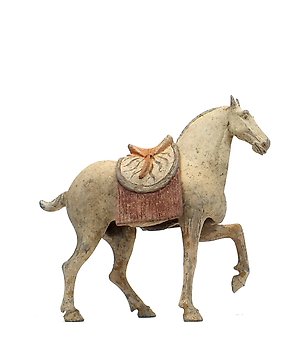
Oud-Chinees Terracotta Schitterend paar beschilderde aardewerken figuren van steigerende paarden met afneembare zadels, met - 35.5 cm
Nr. 84949969

Nr. 84949969

Han Dynasty (206BC - AD220)
Good condition, much of the original pigment remaining.
Wide 18 cm.
Note: It will be professionally packed and safely sent within 3 working days by FedEx. Shipped with Insurance!
Our Guarantee: The above item is guaranteed to be of the time period and condition as described, has been purchased legally and is legal to buy and sell under all international laws to cultural patrimony.
- All items legal to buy/sell under The Netherlands covering cultural patrimony, and are guaranteed to be as described or your money back.
with expressive curved heads and resting on squared bronze webbed feet, decorated with traces of red, yellow, green, brown, pink, and white pigment, bronze feet form later date.
Compare very similar pottery bird on sale by Van Der Ven Oriental art offer in their website for €4800, - the price is for only one piece. See photo # 41
Condition: Wear, old, aged patina, oxidation. The bronze legs from later date, there are made to help the buyer to place the items in very comfortable way. Originally wooden or bronze legs are long gone in the tomb. Very good, preserved condition. Please be advised the pieces are ca. 2000 years old.
Provenance:
private collection, The Netherlands
Asian art market.
Additional Information
The Han dynasty (206 BCE–220 CE)
The Han period saw the gradual abandonment of human immolation. Burial practices were adopted that required a large number of goods accompanying the dead. The result was an increase in demand of mortuary objects made of clay. To make sure that the deceased were well provisioned in the after world, tombs were furnished with rich variety of pottery objects including utilitarian vessels, male and female attendants, livestock, horses and carts, goose, and birds. These objects are fine example of Han pottery sculpture and provide useful information about everyday life of the Han people.
The first pottery to survive in appreciable quantities belongs to the Han dynasty; most of it has been excavated from graves. Perhaps the commonest form is the hu, a baluster-shaped vase copied from bronze vessels of the same name and sometimes decorated with relief ornament in friezes taken directly from a bronze original. The hill jar, which has a cover molded to represent the Daoist “Isles of the Blest,” is another fairly frequent form, and many models of servants, domestic animals, buildings, wellheads, dovecotes, and the like also have been discovered in graves.
Han glazed wares are chiefly of two types. Northern China saw the invention, presumably for funerary purposes only, of a low-fired lead glaze, tinted bottle-green with copper oxide, that degenerates through burial to an attractive silvery iridescence. High-fired stoneware with a thin brownish to olive glaze was still being made in Henan, but the main centre of production was already shifting to the Zhejiang region, formerly known as Yue. Yue ware kilns of the Eastern Han, located at Deqing in northern Zhejiang, produced a hard stoneware, often imitating the shapes of bronze vessels and decorated with impressed, bronze like designs under a thin olive glaze. Other important provincial centres for pottery production in the Han dynasty were Changsha (in Hunan province) and Chengdu and Chongqing (in Sichuan province).[1]
Important information.
The seller guarantees that he is entitled to ship this lot.
It will be professionally packed and safely sent by FedEx.
Buyers are responsible for import regulation and restrictions of their own country
1- britannica
Zo koop je op Catawiki
1. Ontdek iets bijzonders
2. Plaats het hoogste bod
3. Veilig betalen